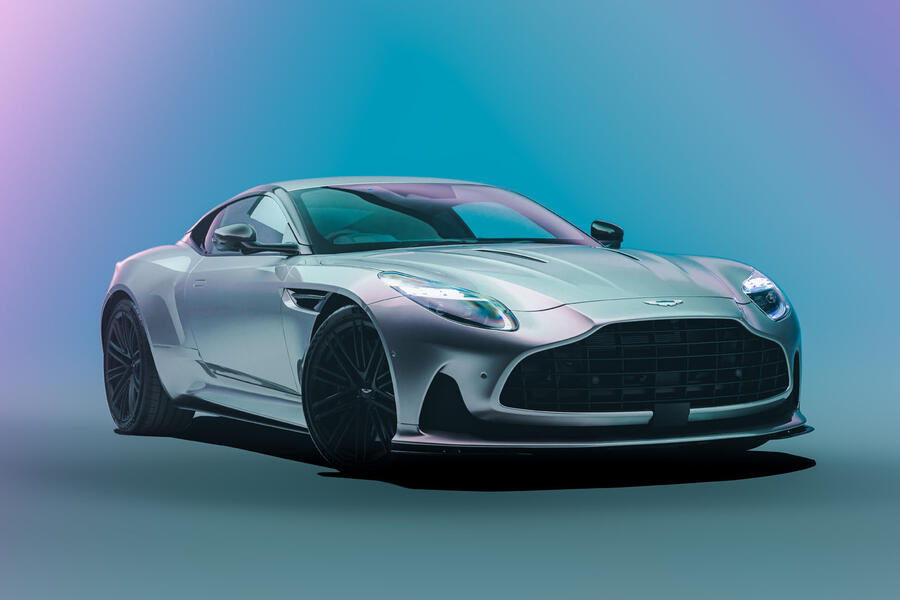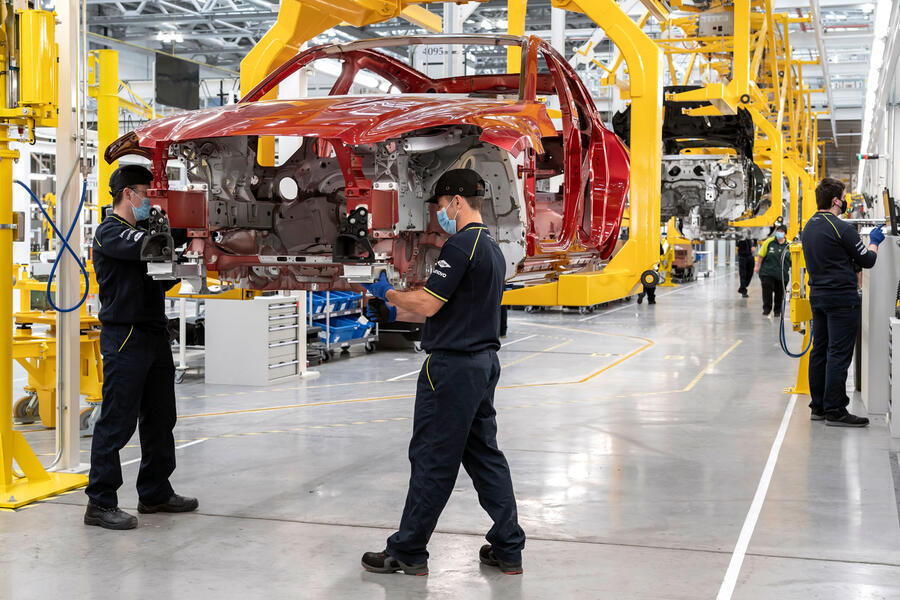Opinion
Lawrence Stroll: The Right Boss for Aston Martin – An Editor’s Letter

"Launching a car is like watching paint dry, your grass grow: it takes for f***ing ever"Clear, effective communication marks Stroll out as the right man for the job of reinvigorating Aston
Four days before we recently sat down with him, Lawrence Stroll delivered two press conferences in a day. That’s not uncommon for a billionaire in the public eye with multiple business interests, yet these two press conferences were continents apart.
At 11am Tokyo time, he announced a new engine supply deal with Honda for his Aston Martin Formula 1 team, a deal he hopes will enable Aston Martin to challenge for championships.
As soon as that was done, he got in his private jet and headed back west, to Monaco. Seventeen hours later, Stroll had landed back in Nice, headed to his yacht to take a shower and then on to the Hotel du Cap-Eden-Roc to unveil the new DB12 road car to the world. How do you spend your Wednesdays?
The day after we spoke, his F1 team were set to move into a new factory at Silverstone he’s funded, and in the interim, there was the small matter of the Monaco Grand Prix, where one of his cars was starting on the front row. We walked into his office at just before 13.15hr, the race due to start at 15.00hr.

Stroll was rather obviously a busy man. With all this in mind, I wasn’t expecting the most newsworthy audience with someone who’d have more than one eye on the clock, with his next diary appointment being of that magnitude; a hello and a handshake, perhaps. But no: the audience lasted almost 45 minutes and the Stroll I thought I knew was very different from the one who was in front of me.
Anyone who’s seen Stroll on Netflix’s Drive to Survive will see a man edited to be a bit bolshy, of few words and quite scary. In person, he’s anything but. While not a man I’d fancy dinging the car door of in the Waitrose car park (or perhaps yacht of in the Monaco harbour), he’s a great storyteller and a very clear speaker, deliberate with words but eminently quotable in almost everything he says. He’ll dominate a room but not feel imposing with it, and he’s a surprisingly rare commodity for an interviewer: he’ll answer the question you’ve asked and not try to spin a pre-rehearsed line or stick to the company message. I liked him.
How many bosses would have dodged a question about whether in hindsight they’d have opened a new factory, as Aston did in St Athan to build the DBX? Most would have at best talked around it for fear of upsetting anyone. Stroll simply said he wouldn’t have opened St Athan, but as he’s got it, he’ll be using it. An expansion of Gaydon holds more appeal and may yet be on the cards. The journalist is happy with the quote, the St Athan workers reassured, the Gaydon workers excited: all from an honest answer with no ambiguity.

Stroll also talked about Geely’s investment, mid-engined cars, electric cars and his plans for both the road car business and the F1 team. F1 is the hardest business he’s ever worked in, he said, while “one thing I learned to the automotive industry launching a car is like watching paint dry, your grass grow: it takes for f***ing ever. My patience level is usually not that much…”.
The DB12 is the first Aston fully created under the Stroll era and the company’s future plans will be revealed in full on 27 June at a capital markets day. With Stroll in the presenting chair, it will be a must-watch performance.
I hope these appearances are just the start of hearing plenty more from him. Good leaders who communicate well inspire confidence in companies. A communicator like Stroll in regular full flow is just what Aston needs to get back on the front foot after the gloomy IPO and the energy-sapping Tobias Moers experiment.
Volvo’s Cost-Saving Techniques for the EX30

Pricing places the EX30 in competition with the Vauxhall Corsa Electric, Jeep Avenger and Kia Niro EVPriced from £33,795, Volvo's new crossover is a convincing proposition against more expensive rivals
When new cars are revealed, it’s quite common to look at the price and go ‘how much?’. That happened with the Volvo EX30 – but, unusually, it was because the price is (whisper it) surprisingly low.
Now let’s be clear: this is all relative. At £33,795, we’re not in affordable car territory here. Volvo hasn’t suddenly turned into Dacia. But still, that’s a hugely competitive price for a compact but well-proportioned bespoke electric car with Volvo’s popular, premium design and a decent level of standard kit.
It’s close to what you’d pay for a similar combustion-engined premium small SUV. And consider this: you could pay more for a Vauxhall Corsa Electric, Jeep Avenger or a Kia Niro EV. You actually question if Volvo could have charged more without really hurting demand.
There are some caveats, not least that the headline-grabbing price is for the entry-level model that features a cheaper LFP battery and offers a relatively meagre 214-mile range – substantially less than many of those cars mentioned above. You’ll pay a hefty £5000 more for the bigger battery.
That price is in part down to some of Volvo’s neat design touches, which are driven not only by reducing cost but also by increasing sustainability and maximising interior space. So the decision to use a single soundbar across the dashboard in place of six door-mounted speaker reduces the number of parts and amount of wiring needed, and creates space in the doors.

Moving the window switches from the door panels to the centre console also reduces the wiring needed. And removing the driver info display and merging it with the central touchscreen – a Tesla-esque decision that might raise some eyebrows – also reduces parts and cost. Still, when you sit inside, it doesn’t feel like those decisions were made purely to keep the price down.
And here’s another reason that headline £33,795 price is lower than some rivals: whether you walk into a dealership or order online, that – or more likely whatever the final PCP figure is – is what you’ll pay.
Volvo’s new integrated ‘agency’ sales model, which will shortly come into force in the UK, means the price is set, whether you buy online or at a dealership (or even through a combination of both). There’s no haggling to be done, no deals to be had. So unlike some new model prices, there’s no margin in the initial figure to try and argue it down.
Volvo admits that some buyers love the thrill of negotiating a deal – but it says its research shows around three-quarters don’t, that instead of feeling like they’re bagging a bargain, haggling simply creates a fear they’ve paid more than they should have.
It’s a concept that’s rising in popularity among car firms eager to take more control of the ‘ownership journey’ and interactions with customers. And it’s going to be a mindset change for many. For the concept to really take off among a public tuned to haggle for car deals, buyers will have to be reassured they’re getting value for money. Still, with the EX30, that shouldn’t be too hard to do.
Vauxhall: Beyond Affordable Fleet Deals – Editor’s Note
 British brand finally has the products to back its upmarket pricing strategy
British brand finally has the products to back its upmarket pricing strategy
For much of its recent past, Vauxhall seemed forever trapped in a cycle of discounting its cars and distress selling at the end of the month, activities that undermine any notion of a brand seeking a positive image and the ‘upper mainstream’ positioning it desired. Then it became part of PSA in 2017 and things began to change.
Back then, the average price of its cars sold, once adjusted for relative vehicle line ups and specification, sat six to seven percentage points behind Volkswagen. Now the firm says it sits 2.3% ahead in the year to date and it expects to end this year 2.5-3% ahead.
In that time, the average Vauxhall has changed from an Astra costing around £16-17,000 and with monthly payments in the low £200s, to being a mid-range Mokka for between £25-27k, the average monthly payment between £400-450.
While Vauxhall’s sales have declined overall in that time, its retail share of the market of 5.5-6% has remained steady, the decline coming in the likes of cheap fleet deals that also armed residuals at the same time.
Under PSA (and now Stellantis), Vauxhall took the bold step to increase its pricing to head towards the brand it wanted to be, but without the overall product quality to support it. Yet with the much-improved Corsa, Mokka and Astra leading the charge of this new Vauxhall, the products have arrived and are performing well, Vauxhalls being bought for reasons other than simply being a cheap deal from a local dealer that always had availability.

Wait times in retail sit at around 100 days, and closer to one year in the fleet market due to the popularity of its electric vans; before there were no wait times. “It’s unprecedented to go to the end of the month relying on logistics [to get cars registered], not pre-registered,” says Phil Douglass, Vauxhall’s marketing director. “People are now focused on getting cars from the port to retailers, not distress selling.”
Vauxhall design boss Mark Adams describes PSA’s takeover as “well timed” as it “allowed us to rethink Vauxhall and what we stand for. It started with the designs [including the firm’s new Vizor grille] but we’re now executing the whole brand to customers in a consistent way, with dealerships and all customer exposures all very different to the past”.
Under General Motors ownership, Vauxhall was tied in with Buick, its architectures having to work on cars sold in the wildly different markets of the US and China. That made Vauxhall “do things we didn’t want to do”, says Adams, in contrast to being with PSA, “a well-run, European-focused group that got us healthy quickly and gave us a European toolbox to work from. It allowed us to be true to what we wanted to be”.
At the same time, Vauxhall abandoned its jingoistic Rule Britannia campaign and branding and instead focused on three new brand pillars: progressive Britishness, detox and ‘greenovation’. The former relates more to tying Vauxhall to the more outward-looking, innovative side of Britain; detox refers to the firm simplifying its trim levels, communications and even the model range (“we were spread too thinly, and more niche oriented,” says Adams, “we’re now positioning vehicles in the sweet spot of segments”); greenovation is about ensuring the firm is seen as a leader in EVs as part of its plans to go EV only by 2028. In April, it had almost 10% of the UK BEV market, including vans, to take the number one position.

Vauxhall is not there yet in being the brand it wants to be: much of its success has come with younger and older buyers, increasing its appeal to 25 to 45 year old buyers is therefore the obvious opportunity, says Douglass.
Yet questions over whether Stellantis needs to have Vauxhall anymore as a separate brand to Opel have gone away for the first time in living memory. It’s one thing to change the products and designs a car maker makes, quite another to shift the brand’s perception. Vauxhall is on its way to succeeding with just that.
“Aston Martin DB12: Importance of Fine-Tuning”

The DBS 770 Ultimate (pictured) offers the guiding philosophy for the new DB12Aston's most recent outing for this kind of car was the superb DBS 770 Ultimate, and V8 power should enhance the handling
There are two reasons to be optimistic about the new DB12, at least so far as what it means to those of us who care first and foremost about, yes, the driving experience.
Reason one is the existence of the recent Aston Martin DBS 770 Ultimate. Sure, different model line. But the DBS was built on the same platform as the Aston Martin DB11 and that platform now underpins the DB12, so there are synergies.
The point here is that the 770 Ultimate was the last car out of the mould that we’ve so far driven and it is exceptionally good, owing to small optimisations designed to heighten precision and also pliancy, as well as making the powertrain more exploitable. The 770 Ultimate is an exhibition in controlled aggression and fitness for purpose, and learnings will have been carried forward into the DB12. The guiding philosophy of the car is close to perfect. I’ll just temper all this enthusiasm by highlighting that the DB12 is getting a Vantage-style e-diff, whereas the DBS used an old-fashioned fully mechanical part, which was always predictable and effective (it was 664lb ft that sometimes made the car snappy). I only hope it feels natural.
Reason two is, a little counter-intuitively, to do with the loss of the twin-turbo V12. Yes, the loss. When it came to the DB11, the V8 version was without doubt sweeter to drive than its bigger sibling.
Part of that was down to the fact that the Mercedes-AMG-engined DB11 was the first Aston that then chief engineer Matt Becker got his chassis-whisperer hands on, and of course this improved set-up was later rolled out to the V12.
But the smaller engine made the car naturally more vivacious and accurate. It was the better engine on the road, if not in the brochure, and the DB12’s lighter wheel-and-tyre package and stiffer front edge should enhance matters further.
Aston Martin normally needs a good few years to wring the best out of its products, but there’s a sense that this time round, its latest "super tourer" could be a banger straight out of the box.
